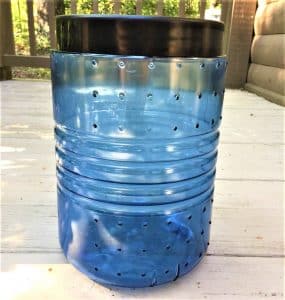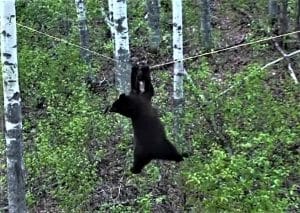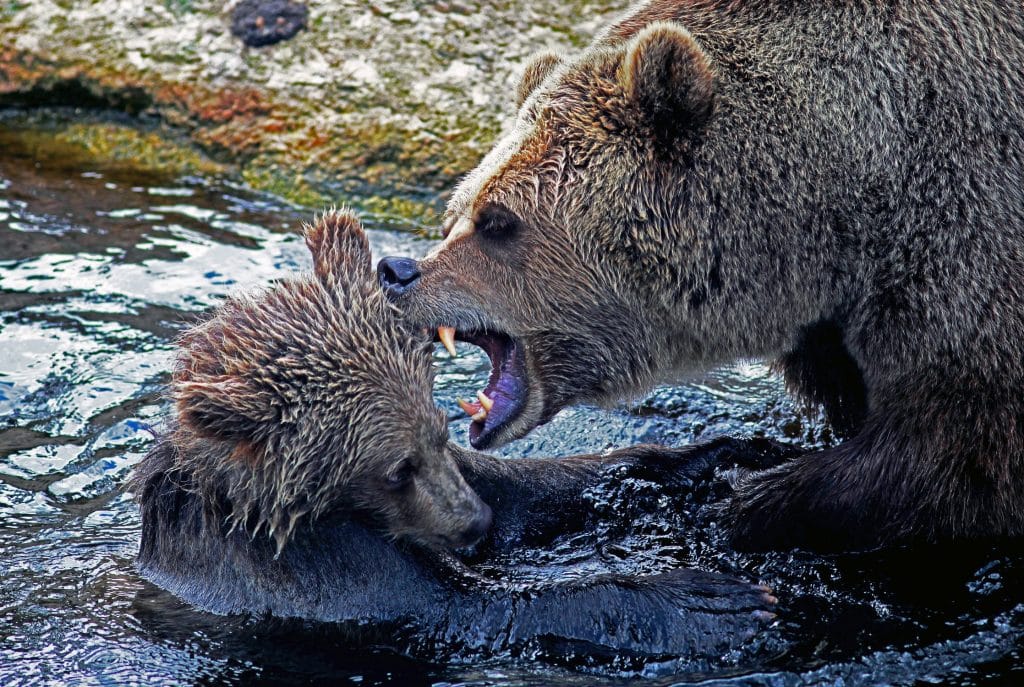In bear country you can’t count on your food being safe overnight if you don’t take the right precautions. Even hanging a bear bag has its problems when it comes to hungry bruins. Yogi Bear is just waiting around the corner, ready to do some acrobats to get your picnic basket. The only way to stop him is with a purpose made bear canister(See My Favorite Bear Canister).
Why Get a Bear Canister?

The traditional method backpackers have been using for centuries is hanging their food up in a tree to avoid hungry bears. Unfortunately bears are a crafty breed and will climb, claw and dangle to rip down your food bag. A bear that’s been successful once will never stop trying to get your food. The better alternative is a bear canister.
There are a few brands on the market, but my favorite is the Bear Vault Bear Resistant Food Canister. Tested to keep out even the smartest Grizzly and Black Bears. Store all of your food and scented items safely in the see through Bear Vault. Just fill it up and use the guides to strap it onto your backpack. You’ll be on your way in no time.
Not only are you protecting your food from bears. It will be kept safe from raccoons, possums, squirrels and even rodents.
Bear Canister Vs Hanging a Bear Bag
- Advantages: The main advantage bear canisters offer is piece of mind. You won’t have to mess around with finding trees and hanging your bear bag. Plus your food is guaranteed to go undisturbed throughout the night. It’s protected against all wild creatures, not only bears. I’ve had some serious problems with squirrels wreaking havoc on my hanging food bag.
- Disadvantages: The primary disadvantage that your going to have is ease of transport. Most canisters are heavy and cumbersome to withstand the weight of a full grown Grizzly. Another concern of many hikers is the high price tag.
Why Bear Canisters are Helpful
Bears have a great sense of smell, sniffing out human food like they were gourmet chefs. Researchers estimate that bears can smell almost as good as a well trained tracking dog. They can pick up subtle scents from miles away, so it should come as no surprise when they traipse through camp looking for food.
In the old days bears had a natural fear of humans and campers slept with their food. No bear was bold enough to enter camp and steal your private food stash. Unfortunately irresponsible campers gave bears a taste of food making them more bold. They invaded camp scaring the pants off of usually sleeping campers.
For years people tried hanging food bags suspended over tree limbs, but bears quickly figured that out. They switched to more elaborate methods that were extremely time consuming. Hanging bags over branches and rigging up counter balances, it was a tiring process. A lot of people still use the counterbalance method where park rangers allow it.
Bears Find a Way

Bears aren’t stupid, they find a way to beat every elaborate hanging method we come up with. Often sending cubs to climb across branches cutting the rope. They’re like aerial acrobats dangling off a trapeze.
Once they’ve been introduced to human food they’re hooked and go after it every chance they get. They go to extreme lengths to try to get their grubby little paws on your lunch. Bear canisters like the Bear Vault or Frontiersman Insider are your last line of defense. Who knows how long it will be until bears get wise enough to open our bear canisters.
How To Use a Bear Canister
When going out into bear country you need to limit the amount of food you bring along. Bear canisters are small offering a limited amount of storage. All food, toiletries, trash and otherwise smelly items need to be placed inside a IGBC Approved bear container.
What Needs To Go Inside?
- All Packaged Food
- Sunscreen and Mosquito Repellent
- Deodorant and Perfume/Cologne
- Soap
- Lip Balm and Makeup
- Medication
- Feminine Hygiene Products
- Anything Else that Goes in your mouth or on your skin
Bear Canister Steps
- Prepare all of your food and remove all commercial packaging to increase usable space.
- Fill your canister up to the brim and store it at least 100 yards away from your tent. You should also make sure you store it downwind so you aren’t laying between the food and a hungry bear.
- Keep your canister closed and locked, even when you’re nearby. Most of the time a bear will ignore you and head straight for the canister. Canisters will only work when it’s closed and locked.
- Store Your Canister on the ground and hide it behind brush or rocks. Never store it next to a hill or by the edge of a cliff, because it will be battered off.
- Make sure you remove any straps and ropes from the canister while storing. If he can’t get it opened he’ll carry your canister off into the woods for later.
Reduce The Amount You Carry
- Everything you buy needs to be bought in bulk and then repackaged into smaller ziplock bags.
- You can carry more food if you look for dehydrated items. Aim for low volume foods that are high in calories because they take up less space. Think pastas, jerkies, nuts etc.
- Remove all of the commercial packaging and put it into smaller bags. Consider tossing in your spices while your at home. Remember just because you bought a 5 lb bag of rice doesn’t mean you have to bring it all.
- Label all your bags with basic cooking instructions and what should go with it.
- Reducing your packaging minimizes the amount of trash you need to pack out.
- Consider buying dedicated camping cookware. Here are a few of my favorite camping cookware sets.
Where to Place Your Canister

For your own safety you want to minimize the amount of time you’re with food. You should never have food in your actual campsite. That also means that you shouldn’t cook your food in the campsite.
Bring along a compact cooking stove and cook at least 100 yards away from your camp and food storage location. Both your makeshift kitchen and storage location needs to be downwind from your actual campsite.
To setup a food storage spot just start walking downwind from your camp. That is unless you want to wake up to a hungry bear. The farther you walk the better, but 100 yards is normally about perfect.
Look for areas away from hills that have decent landmarks, so you don’t forget where you put it. Your best bet is going to be to hide your canister in bushes or behind rocks, but it really doesn’t matter all that much. With a great sense of smell you’re really just buying time before some critter stumbles upon your canister
Other Useful Tips
- When hiking and backpacking strap the canister to the center of your pack. Make sure it’s as close to your back as possible centered between your shoulders. Just remember to remove all your straps after you setup camp.
- Place canisters approximately 100 yards away from your campsite. I’ve seen experts recommend 100 feet, but who wants to sleep that close to a hungry agitated bear.
- Flip your canister upside down to reduce the chance of bears damaging your lid gnawing on the top of the canister.
- Stay away from water and lakes unless you want to lose your stash of food.
- The Interagency Grizzly Bear Committee recommends storing your food in odor-negating bags. OPSAK storage bags are probably the best option, and they work like ZipLocks.
Bear Canisters Protect The Local Bear Population

Unfortunately once bears start to get accustomed to human food it changes their foraging habits. They start to get aggressive around backpackers endangering everyone involved. Harassing campers for food makes for a quick trip to Bruin Heaven. One or two complaints of a problem bear is all it takes to get him euthanized.
Thankfully bear canisters are extremely effective and have been lowering human-bear interactions. Unfortunately humans make mistakes that could cost a bear his life. The only way to stop human bear conflicts is 100% compliance across the board which will likely never happen.
Sometimes Canisters are Required
In a lot of national parks bear canisters aren’t just recommended their required by law. Most major national parks are now requiring bear canisters over bear bags. The last time I was in Yosemite Park Rangers were actually checking to make sure people brought along a canister.
It’s a nuisance, but they’re protecting the local bear population more than the campers. Some parks even offer loaner canisters and lock boxes to store your food in. You can either contact the local park office or be smart and just bring along a canister.
More Ways to Avoid Bears
Extremely smart and with a stunning sense of smell, bear encounters happen more often than you’d think. Bears can run faster than us, swim better, and even climb trees. If a bear wants to get a piece of you there’s no stopping him.
Most bears, including grizzlies, rarely seek out a confrontation with humans. Though black bears are a little bit more inquisitive when it comes to food. If you do everything right you should be able to deal with pesky bears.
- Don’t camp in heavy brush where bears normally frequent. Look for signs of bear activity, including droppings, animal tracks and scraped up camp sites. Bears are also known to frequent watering holes so avoid the waters edge.
- Never bring food into your campsite or even worse, your actual tent.
- Always keep your food in bear proof containers until you actually plan to eat. After you start cooking never leave your dinner unattended even for a second.
- Keep your site clean and try to get rid of any trash that might attract animals. You can even burn up some of your wrappers to dispose of them.

